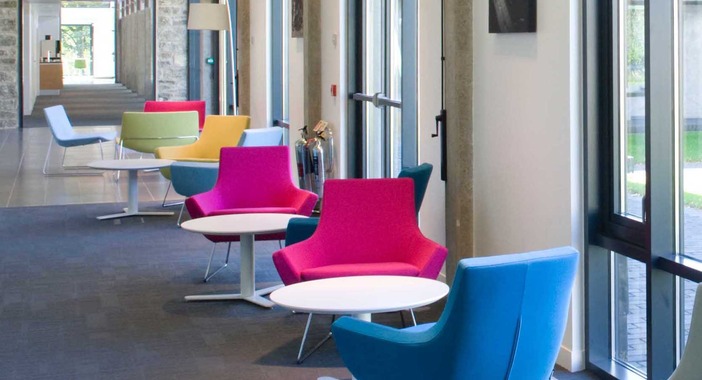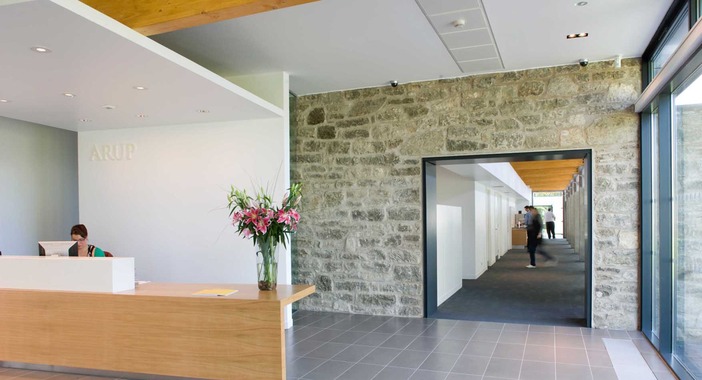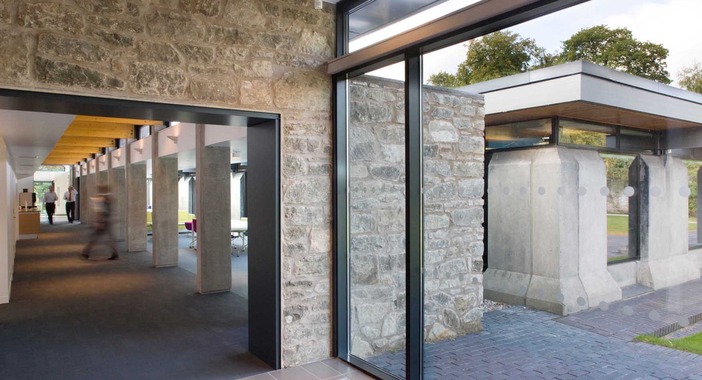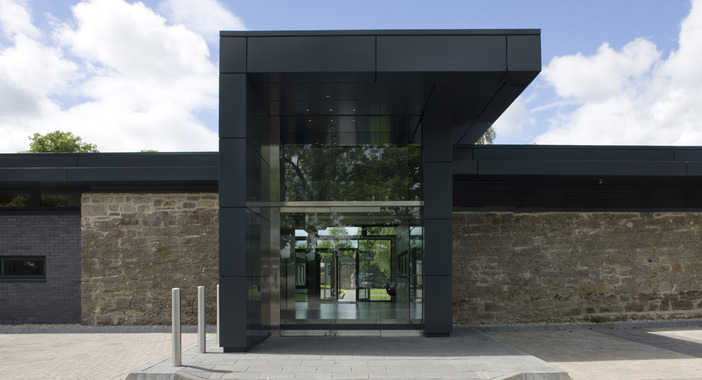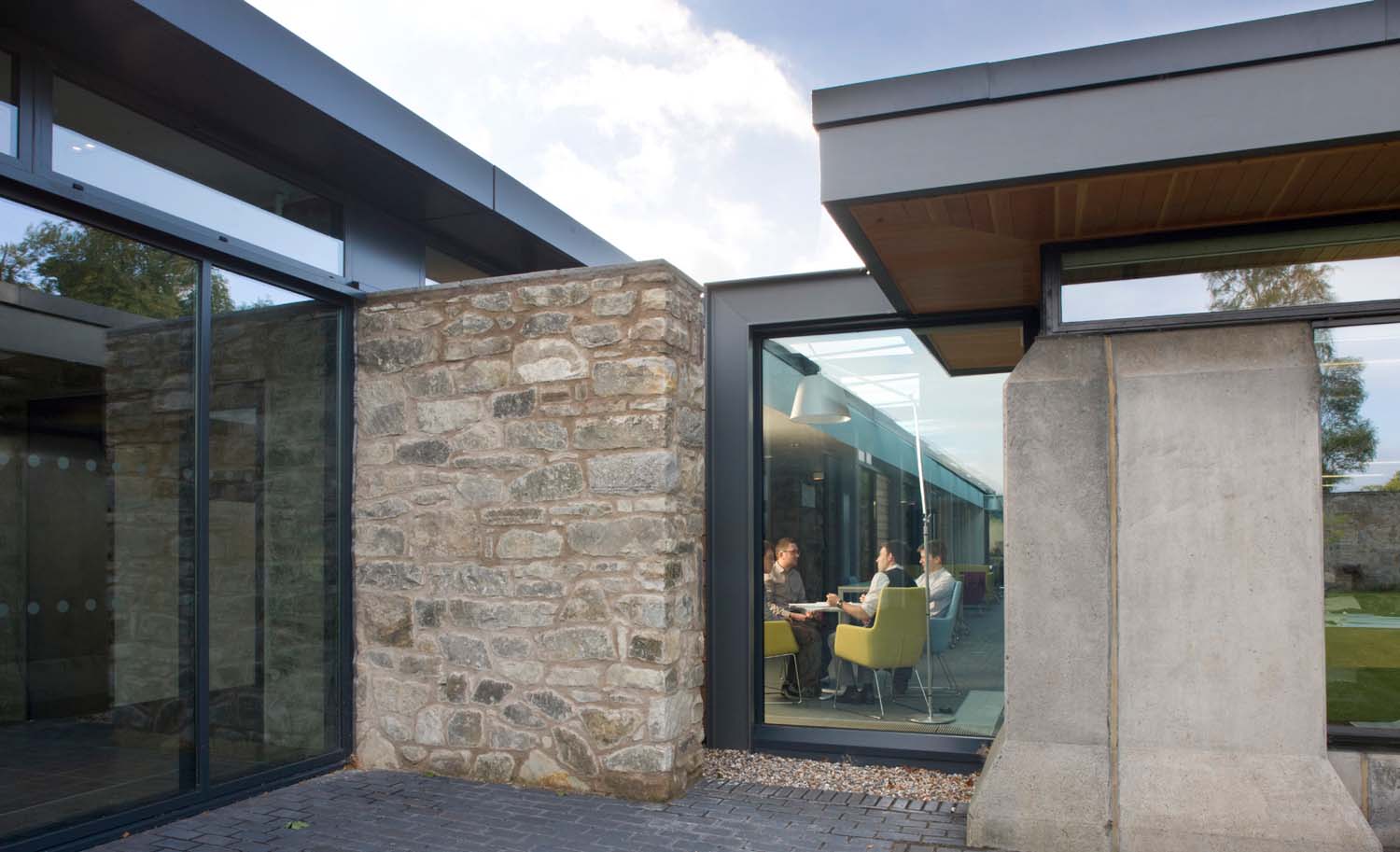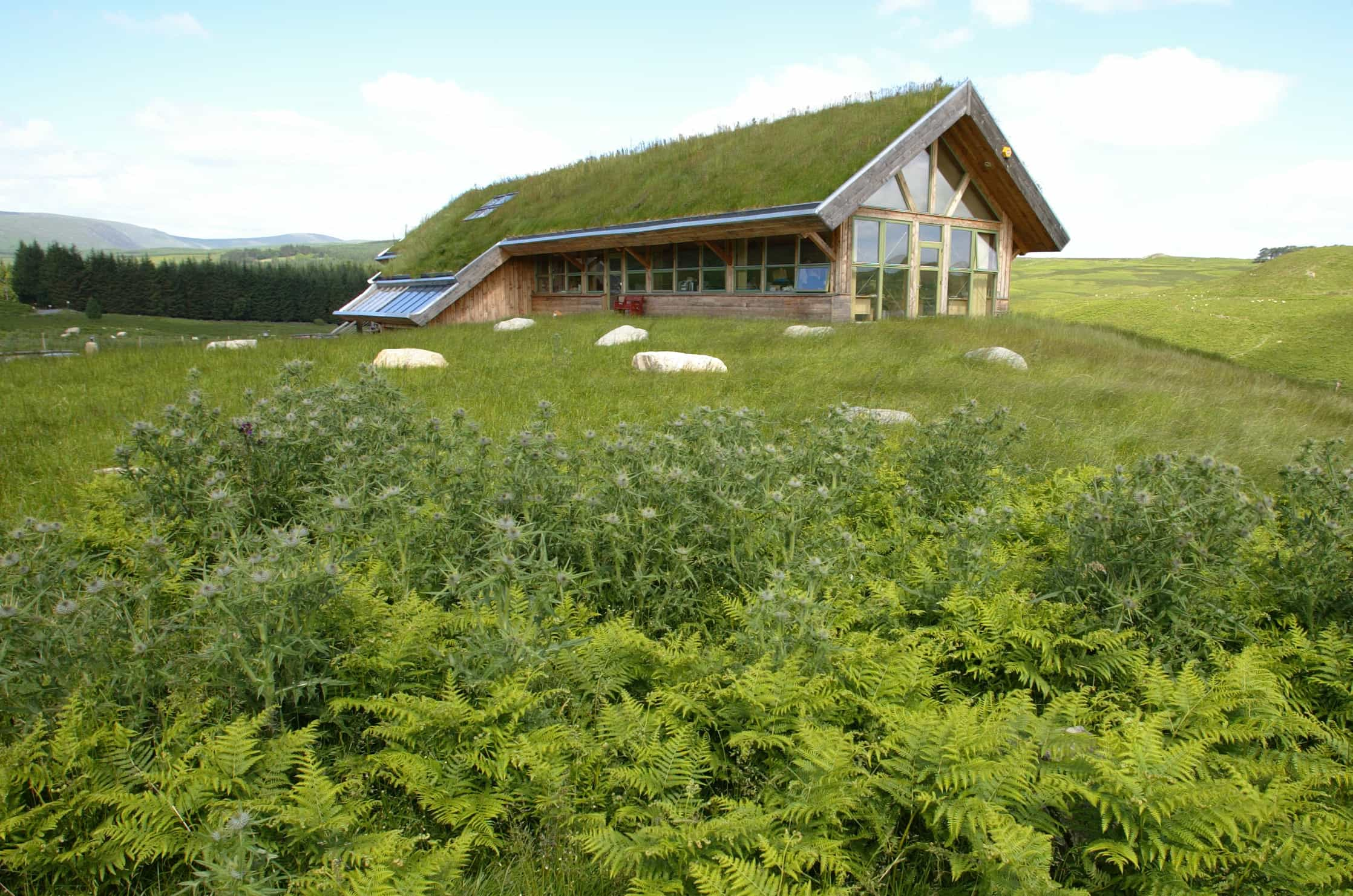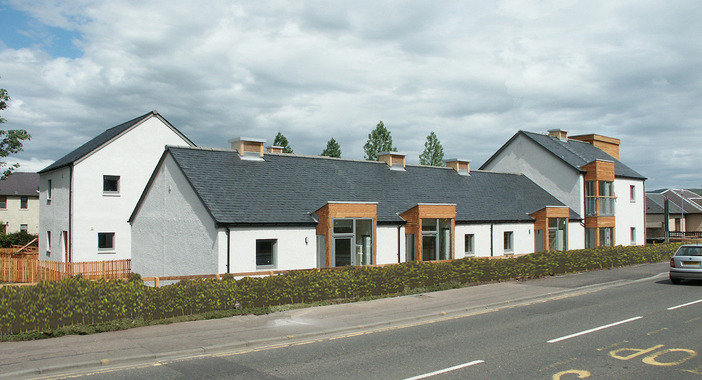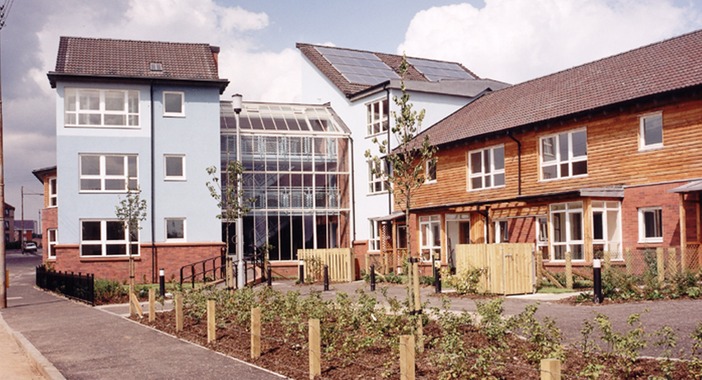Scotstoun House
An office that achieved a BREEAM Excellent and EPC A-rated building.
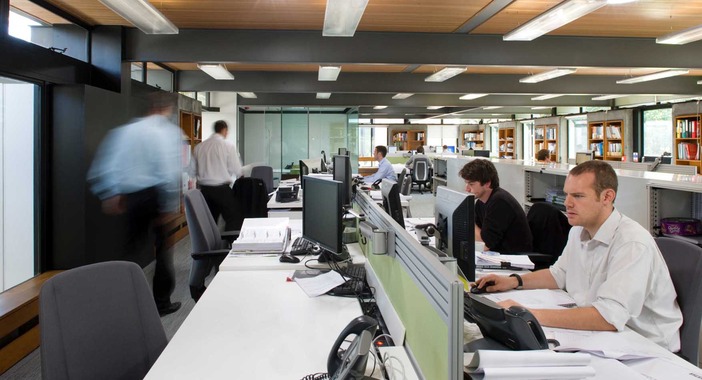
In 1965, Arup Scotland purchased Scotstoun House at South Queensferry due to a lack of space in their central Edinburgh offices. They demolished the 18th century house and in 1966 built a low, single-storey, pavilion-like office building (designed by Peter Foggo of Arup Associates).
Despite some affection for its growing status as a classic building of the 1960s the office was an uncomfortable place to work and didn’t provide a good image for Arup in the 21st century.
Find out how the adaptation and extension of a poorly performing but listed 1960s office building achieved a Building Research Establishment Environmental Assessment Method (BREEAM) Excellent and Energy Performance Certificate (EPC) A-rated building and meets Arup’s needs for the next 20-30 years.
Case study: Scotstoun House
An office building unfit for purpose
Originally designed to house 60 people, the building had 100 members of staff working in it by 2005. The space was crowded and other issues with the building included:
- inflexible cellular layout which doesn’t suit the way the company wanted to work
- poorly ventilated system
- a single meeting room
- limited facilities such as staff kitchen
- lack of room for printing equipment
- a prefabricated structure which had been tacked onto the building for archives storage
- limited insulation in the concrete and glass structure (staff were cold in winter and overheated in summer)
- window blinds were down continuously to protect staff from glare, heat or cold
- the building was dark with fluorescent strip lights on for 12 hours every day
Keeping an open mind to the building process
From converting to extending or demolishing to selling, Arup kept an open mind to the overall building process. They commissioned Haa design to look closely at their business, to gain a better understanding of:
- how they wanted to work
- what the business might look like in 20 or 30 years’ time
- how to meet future needs with their existing site and building
A development during the process
In 2005, during the process of developing the brief and after Haa had drawn up an initial design for extending the existing building on two sides, Historic Scotland spot-listed the building as B grade.
The factor of the listing brought the options for Arup and the development of the building into closer focus. They had to preserve the 1960s building areas such as:
- interior furnishings
- walls of the kitchen garden
- cottage and outbuilding
- pavilion like settings of the new building
This created a challenge for Arup. They had to meet their and Historic Scotland’s aspirations of preserving the building. If they could not alter or extend the building towards the company's needs, they would have had to move or develop on a different site.
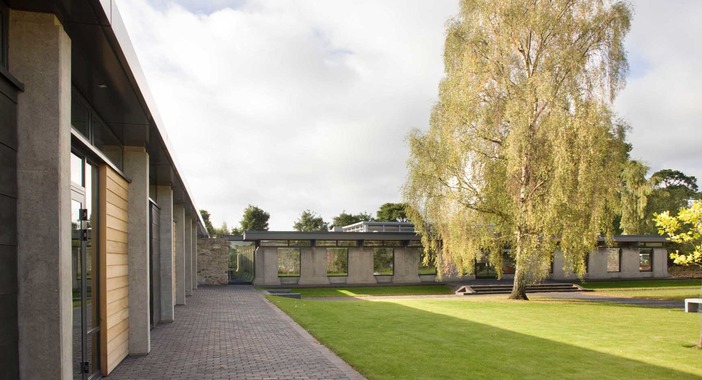
Sustainability as its core design concept
One aspect of sustainable design was embedded in this project from the very beginning—the re-use of an existing building and its ultimate conversion to meet present-day standards of energy use and environmental quality for its occupants.
Image credit: Alan McAteer
Design approach
Continuing to work on how to accommodate Arup’s needs, Haa design proposed the creation of a simpler addition. Connecting the south-east face of the existing building and extending within the space of the walled garden.
With its height carefully designed to complement the 1966 building and new and old separated by a clear link, this proposal satisfied Historic Scotland’s requirements. It enabled the 1966 building to exist separately, leaving its relationship to the garden and the park clear.
The proposal satisfied Arup’s requirements of providing an additional 625 sq. m. of space. It accommodated:
- a new range of core service areas
- meeting rooms
- break-out spaces
- a new entrance into the building
- a much better public face to the business
This overall process was only feasible due to continual conversation between Arup as a client, Haa design, Historic Scotland and the planning authority The City of Edinburgh Council (CEC).
As a recognised leader in promoting sustainable design, Arup was in the process of developing a strategy for designing sustainable buildings, using their expertise for their clients' contractors. Arup published ‘Designing Sustainable Buildings', following their strategy of sustainability.
Their directors in Scotland set a target of the new building to achieve a BREEAM rating of ‘Very Good’ and an EPC A-rating.
Engineers from Arup’s Edinburgh office became part of the design team, and staff in their London office also provided input.
While designing the building, the City of Edinburgh Council had a staff team dedicated to assessing the sustainability of planning proposals, requesting proof that the building would achieve BREEAM ‘Very Good’.
This required a full sustainability assessment before the planning application was lodged. They also expected the building to conform to Section 6 of the 2008 Scottish Technical Standards. Desirable, but not a requirement for a refurbishment project.
With a dedicated BREEAM facilitator in the Edinburgh office and full backing from Arup directors and staff in both Edinburgh and London, the sustainability assessment for the building started at RIBA Stage B and was fully valued by Stage C.
Embedding sustainability in the conversations from an early stage meant that the approach agreed was naturally part of the design and planning conditions.
Although detailed measures were a subject of continual discussion and cost-checking, the team were committed to prioritising sustainability. Measures were in fact enhanced as the project developed, with the building finally achieving BREEAM ‘Excellent’.
From the beginning, the project had specific aims of bringing as much natural light as possible into both the old building and the new extension. This was to provide:
- excellent air quality
- cooling and ventilation through passive means
- low-carbon source of heating
- reduced energy bills and carbon emissions
Firstly, the plan, form and orientation of the building were determined. Thereafter an extensive analysis of the existing building and modelling of airflows, temperature variations etc., was carried out to detail the performance of the external envelope and refine the design.
Glazing and ventilation solutions and selected low energy systems were also specified.
Historic Scotland appreciated how the new design showed off the old building's character. This included preserving its external walls, opening its interior spaces and letting in more natural light.
Regular communication between Historic Scotland and the CEC planners resulted in both bodies buying into the changes proposed by the design team.
For example, Arup’s environmental modelling prediction of over-heating in one corner of the old building led to a proposal, changing two fixed windows into opening French windows. The changes created a shorter link between the old and new building to increase the flow of air.
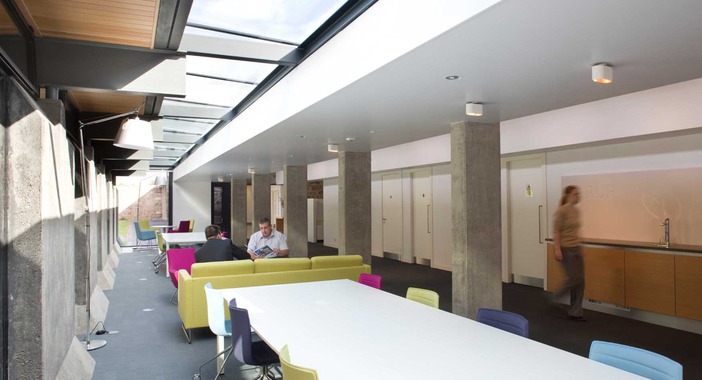
Strong collaboration and communication
Developing a close working relationship with the main contractor was critical to the project's success. The process of procurement for this project were also traditional—a method of procuring building works that involves separating design from construction.
Image credit: Alan McAteer
Building and development process
Detailed discussions took place prior to contract sign-off, so that key construction elements and building sequences were fully understood.
This resulted in a realistic programme and generated a sense of ‘buy-in’ which worked to all parties’ benefit as the project progressed.
Haa design spent a considerable amount of time analysing the working patterns of the Arup staff for the brief, such as:
- how teams interacted
- how copy points, recycling points and tea points would be used
- how incidental meetings could be promoted
- detailed storage needs
They also gathered input from the directors of the Edinburgh office, a Scotstoun User Group (representatives from each main work area) and board members of Arup in London.
The team reduced the need for new construction materials, as they retained and re-used the main structure and external walls of the existing building.
The extension also utilised one of the existing garden walls, which was levelled and underpinned. Another section of the wall was partly demolished, stored and rebuilt as part of the redevelopment.
On-site material was stored, crushed, and used for granular fill across the site and under road bases. To reduce construction waste on-site, they also used some elements of prefabrication.
Conversely, the nature of the old building and the materials that did have to be retained (walls, window format, timber, steelwork etc.) meant that only limited intervention in the old building was possible.
This meant close attention had to be paid to how solar gain, heat build-up, ventilation paths and so on were achieved
The designers proposed several low-energy technologies during the design process. However, some were uneconomical for a building that size and unsuitable for the design such as ‘rainwater harvesting’.
The parkland surrounding the building provided opportunities for the team to install swale to capture and disperse all run-off water and sustainable urban drainage system for external areas.
Glossary | Swale: A sunken channel or marshy area with slopes on either side.
The design team selected materials based on a Green Guide A rating, such as natural, inert and recyclable materials.
The new extension also reflected the tone of the existing building, using primary materials such as concrete, timber, steel and glass
A new aluminium capping to the old building is mirrored in the extension and in the choice of same materials for the new windows, creating strong lines in a soft parkland setting.
Lead was a new material introduced; a softer material selected to tie in with the blue engineering brick on the exterior fringe to the old building
A new experience for staff teams
The move to an open-plan working situation was a new experience for the staff at Scotstoun House. The new locations of administrative staff, filing, and other services in the building required their teams to discover new ways of connecting their teams.
The staff also find the new Scotstoun House a pleasant working environment, an office designed to that contributes to greater productivity.
Employee experience of services and facilities
Staff particularly appreciate the variety of spaces in the building, providing them with the ability to walk away from main workspaces or take a break in a different part of the building. Other features and spaces the staff values are:
- extra meeting rooms
- cycle storage facilities
- shower and changing rooms
- desking arrangement
- levels of lighting
- acoustics of the room
And with the closing of the Dundee office in 2011, the new building accommodated the staff and filing team successfully in the new office at Scotstoun.
A view of the outdoors
The building makes the most of its location, with everyone able to feel part of the green setting and the wildlife that comes with it.
Resolving heating and cooling issues
Through summers, the temperatures in the building remain steady and comfortable, confirming the accuracy of the advanced modelling.
The continued monitoring confirms that the phase-change material (PCM) in the ceiling of the old building is functioning as designed.
Glossary | PCM: A substance which releases or absorbs sufficient energy at phase transition to provide useful heat or cooling.
There is some feeling that the clerestory louvers in the central core of the old building were over-designed, i.e., have more ventilation capacity than is required.
Glossary | Clerestory louvers: A type of window installed near the ceiling and above head height.
Arup’s service engineer working on the project noted that they had omitted to model the heating and ventilation requirements of the reception area—traditionally difficult to service with natural ventilation, due to its tendency to either be too hold or cold.
To overcome this issue, the reception staff open a window to provide ventilation for this area.
Energy usage
Arup has validated the accuracy of the original model compared with the previous building.
They predicted yearly energy usage and demonstrated that the daylight scheme saved 60% of the electrical energy for lighting annually. Modelling also predicts a reduction of 30% to heating costs.
The project was subject to the 2008 Scottish Technical standards for energy usage, which were not only achieved but significantly exceeded.
The refurbished building achieved a BREEAM Excellent rating and EPC A-rating, an outstanding achievement considering the restrictions imposed by the original building.
Arup manages the process of biomass themselves, taking the time to optimise its operation. The team turns it on at night to fill up the buffer vessel of hot water, ready for distribution in the morning.
The client also acknowledges that Scotstoun House has re-established its place within the Arup oeuvre of quality architecture.
Key lessons learned
- Haa design’s previous relationship with Arup and their shared vision (as client and engineers and as BREEAM facilitators) put the project on a good path from the start.
- There was an overall shared vision of sustainability between the Arup offices in Edinburgh and London, showcasing the depth of their knowledge about sustainability and commitment at a fundamental analytical level.
- Haa design’s 15 years of experience in designing sustainable buildings and detailed knowledge of the BREEAM process helped to create an office building that integrates the appropriate technology.
- The team completed the project on time and within budget by developing a close working relationship with the contractor and detailed discussions on understanding key construction elements and building sequence.
- The extent to which Arup was able to model the new building before proposing solutions for heating, lighting, ventilation, etc., contributed to the design of those solutions.
- The team proved the success of the sustainable design solution by monitoring and testing the building's performance once it was in operation.
- The proposals that addressed sustainability became integrated into the development and part of the planning consent—meeting the standards set out by the City of Edinburgh Council for developers.
- The retention and renovation of the old building met the requirements of Historic Scotland’s B-grade listing of the building, avoiding the need for a 100% new build option.
- The building's B-grade listing acted as a major driver for innovative solutions to reach the BREEAM Excellent and EPC A-rating from the limitations imposed by the old building.
Header image credit: Alan McAteer


